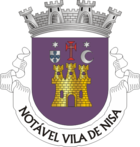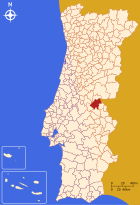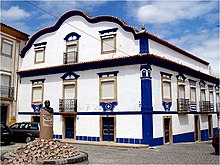Nisa
| Nisa | ||||||
|---|---|---|---|---|---|---|
|
||||||
| Basic data | ||||||
| Region : | Alentejo | |||||
| Sub-region : | Alto Alentejo | |||||
| District : | Portalegre | |||||
| Concelho : | Nisa | |||||
| Coordinates : | 39 ° 31 ′ N , 7 ° 39 ′ W | |||||
| Residents: | 7450 (as of June 30, 2011) | |||||
| Surface: | 575.67 km² (as of January 1, 2010) | |||||
| Population density : | 13 inhabitants per km² | |||||
| Nisa district | ||||||
|
||||||
| Residents: | 7450 (as of June 30, 2011) | |||||
| Surface: | 575.67 km² (as of January 1, 2010) | |||||
| Population density : | 13 inhabitants per km² | |||||
| Number of municipalities : | 7th | |||||
| administration | ||||||
| Administration address: | Câmara Municipal de Nisa Praça do Municipio 6050-358 Nisa |
|||||
| President of the Câmara Municipal: | Maria Gabriela Pereira Menino Tsukamoto ( CDU ) | |||||
| Website: | www.cm-nisa.pt | |||||
Nisa is a small town ( Vila ) and a district ( Concelho ) in Portugal with 7450 inhabitants (as of June 30, 2011).
history
Finds show a settlement since the Neolithic . The Romans built their own fortified village on an Iron Age settlement of the Castro culture . The current name may go back to a villa that was built here in the course of settlement by members of various peoples of the Roman Empire . Nisa is said to have been the name of the Greek owner of the villa, who gave the village its name.
After the conquest of large parts of today's Alentejo by the Moors , King Sancho I gave the local area to the Knights Templar in 1199 . He took care of the settlement, especially with settlers from the south of France, who named the localities after French places. According to this second theory of names, the current place name Nisa (from Nice , French: Nice ) was created. Other place names of today's municipalities in the district are said to have originated in this way, including Montalvão (from Montauban ), Arez (from Arles ) and Tolosa (from Toulouse ).
Between 1229 and 1232 Nisa received its first town charter and became an independent district. During the dispute between the Portuguese King D.Afonso IV and his son-in-law, the Castilian King Alfonso XI. , Nisa suffered severe damage.
King Manuel I renewed the town charter in 1512 as part of his administrative reforms.
coat of arms
The coat of arms shows a castle with the cross of the Order of Christ above the central tower . The Portuguese coat of arms of the Quinas stands above the left castle tower, an Islamic crescent moon above the right tower , while a six-pointed star stands above each of them. The coat of arms reflects the historical development of the place as an Islamic, then a Christian place.
King D. João I gave Nisa the title Notável Vila de Nisa (Eng .: Remarkable Small Town of Nisa) by decree of October 13, 1343 . Since then the place has been named in the coat of arms.
Culture and sights
The thermal springs and the local cheese specialty, the protected sheep's cheese Queijo de Nisa , are known nationwide . The local handicrafts are also known, especially pottery and embroidery . Located in the historic prison building, the Museu do Bordado e do Barro (Eng .: Embroidery and Clay Museum) is dedicated to these local traditions.
The monuments of the place include historic houses and fountains, a number of sacred buildings , and various historic public buildings, such as the cinema, the post office, the hospital, and a quarter of the social housing of the Estado Novo regime. There is also a Roman bridge with a Roman road and the remaining parts of the medieval castle, city wall and gates.
In addition, the historic town center is a listed building as a whole. Thematically sorted tours and hiking trails lead through the town and the district, for example historical or nature-themed tours. Nisa is part of the gastronomic-culinary route of the Alentejo, the Rota dos Sabores . In addition to hiking , bird watching is also carried out in the nature reserves in the area .
administration
circle
Nisa is the administrative seat of a district of the same name ( concelho ), which borders on Spain to the east . The neighboring districts are (starting clockwise in the north): Vila Velha de Ródão , Castelo de Vide , Portalegre , Gavião and Mação .
Until the regional reform of September 29, 2013 , the district consisted of 10 communities, of which Nossa Senhora da Graça and Espírito Santo were the local communities of the district town of Nisa. In 2013, Espírito Santo, Nossa Senhora da Graça and São Simão were merged into a new parish, as were Arez and Amieira do Tejo , so that the district now consists of seven parishes.
The following municipalities ( Freguesias ) make up the Nisa district:
| local community | Population (2011) |
Area km² |
Density of population / km² |
LAU code |
|---|---|---|---|---|
| Alpalhão | 1,238 | 34.23 | 36 | 121201 |
| Arez e Amieira do Tejo | 497 | 158.23 | 3 | 121211 |
| Espírito Santo, Nossa Senhora da Graça e São Simão | 3,569 | 153.66 | 23 | 121212 |
| Montalvão | 442 | 124.17 | 4th | 121205 |
| Santana | 404 | 27.19 | 15th | 121207 |
| São Matias | 289 | 54.66 | 5 | 121208 |
| Tolosa | 1.011 | 23.53 | 43 | 121210 |
| Nisa district | 7,450 | 575.67 | 13 | 1212 |
Population development
| Population in Nisa County (1801–2011) | |||||||||
|---|---|---|---|---|---|---|---|---|---|
| 1801 | 1849 | 1900 | 1930 | 1960 | 1981 | 1991 | 2001 | 2004 | 2011 |
| 3,267 | 6.125 | 13,255 | 16,697 | 17,976 | 10,734 | 9,864 | 8,585 | 8,047 | 7,450 |
The district experienced its most significant growth in the course of the various administrative reforms from the Liberal Revolution of 1822 to the turn of the century. Thus, the independent Arêz and Montalvão districts were dissolved in 1836 and incorporated into the Nisa district, and in 1898, after independence was restored in 1898, Nisa was finally incorporated. The municipality of Amieira do Tejo was separated from Nisa in 1836 and incorporated into the Gavião district, only to return to Nisa in 1895. The formerly independent districts of Alpalhão and Tolosa also became communities of Nisas when they were dissolved in 1853.
In line with the development of large parts of the Alentejo, the Nisa district has also suffered from emigration since the 1960s. Waves of emigration took place in particular in the industrial suburbs that emerged in the early 1960s on the river bank opposite Lisbon, the Margem Sul do Tejo .
Municipal holiday
- Easter Monday
Town twinning
-
 Portugal : Vidigueira (since 1992)
Portugal : Vidigueira (since 1992) -
 France : Azay-le-Rideau (since 1993)
France : Azay-le-Rideau (since 1993) -
 Portugal : Sines (since 1994)
Portugal : Sines (since 1994) -
 Cape Verde : Tarrafal (cooperation agreement since 2008)
Cape Verde : Tarrafal (cooperation agreement since 2008)
economy
The district is dominated by agriculture, in particular cattle breeding, grain and vegetable cultivation, and the production of cork and olive oil are to be mentioned here.
In addition to handicrafts , tourism has also gained in importance, especially in the form of individual tourism , for example in facilities of the rural tourism . The most important asset of the local tourism, however, is the thermal baths Termas da Fadagosa de Nisa . It is known for the therapeutic power of its medicinal springs. An extensive offer in the areas of rehabilitation and wellness, with various health facilities and spa , up to hotels and a campsite, are an essential factor in the tourism of the district.
traffic
Nisa is connected to the municipality of Alpalhão, 12 km to the south, via the national road N18 and its connection to the IP2 (here also European route E 802). The N18 runs to the north, via Vila Velha de Ródão, 18 km away, to junction 19 of the A23 motorway in Tavila, 24 km away . Via a municipal road, past Monte Claro, junction 15 of the A23 is 18 km to the west, near Gardete.
The nearest train station is also in Vila Velha de Ródão, on the Linha da Beira Baixa railway line .
Nisa is integrated in the national bus network of Rede Expressos .
sons and daughters of the town
- Álvaro Semedo (1585–1658), Jesuit missionary in China, 1641 author of a European-wide important book about China
- Joaquim Mendes dos Remédios (1867–1932), writer, minister and university professor, rector of the University of Coimbra
- Tude Martins de Sousa (1874–1951), author, journalist and administrative economist
- Jaime do Inso (1880–1967), naval officer, author and orientalist
- Manuel da Cruz Malpique (1902-1992), writer
- Augusto Pinheiro (1905–1994), painter
- Fernando Eduardo Carita (1961–2013), writer
Web links
Individual evidence
- ↑ a b c www.ine.pt - indicator resident population by place of residence and sex; Decennial in the database of the Instituto Nacional de Estatística
- ↑ a b Overview of code assignments from Freguesias on epp.eurostat.ec.europa.eu
- ^ João Fonseca: Dicionário do Nome das Terras . 2nd edition, Casa das Letras, Cruz Quebrada 2007, p. 179 ( ISBN 978-9724617305 )
- ↑ History page of the city administration , accessed on July 23, 2013
- ↑ www.verportugal.net , accessed on July 23, 2013
- ^ Page on the coat of arms on the district's website , accessed on July 24, 2013
- ↑ www.verportugal.net , accessed July 24, 2013
- ↑ ditto
- ↑ www.monumentos.pt , accessed on July 23, 2013
- ↑ ditto
- ↑ ditto
- ↑ Routes on the district administration website , accessed on July 23, 2013
- ↑ website of the Rota dos Sabores (English, Spanish. And port.), Accessed on July 23, 2013
- ↑ www.avesdeportugal.info , accessed on July 23, 2013
- ↑ Information on the history page of the district website , accessed on July 23, 2013
- ↑ www.anmp.pt , accessed on July 23, 2013
- ↑ www.termasdenisa.pt ( Memento of the original dated May 12, 2013 in the Internet Archive ) Info: The archive link was inserted automatically and has not yet been checked. Please check the original and archive link according to the instructions and then remove this notice. , accessed July 23, 2013









